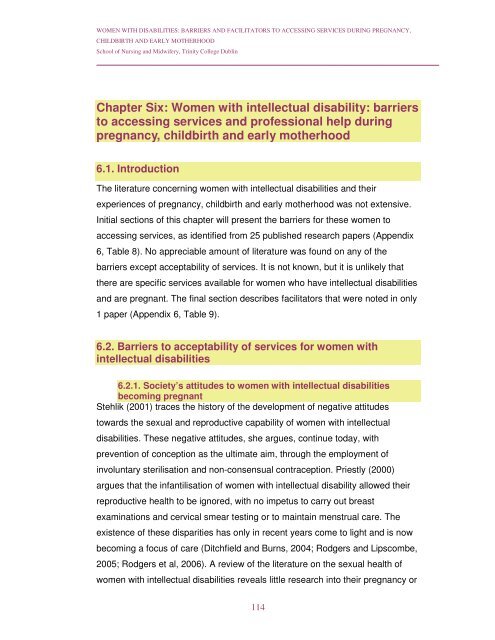Women with Disabilities: Barriers and Facilitators to Accessing ...
Women with Disabilities: Barriers and Facilitators to Accessing ...
Women with Disabilities: Barriers and Facilitators to Accessing ...
Create successful ePaper yourself
Turn your PDF publications into a flip-book with our unique Google optimized e-Paper software.
WOMEN WITH DISABILITIES: BARRIERS AND FACILITATORS TO ACCESSING SERVICES DURING PREGNANCY,CHILDBIRTH AND EARLY MOTHERHOODSchool of Nursing <strong>and</strong> Midwifery, Trinity College DublinChapter Six: <strong>Women</strong> <strong>with</strong> intellectual disability: barriers<strong>to</strong> accessing services <strong>and</strong> professional help duringpregnancy, childbirth <strong>and</strong> early motherhood6.1. IntroductionThe literature concerning women <strong>with</strong> intellectual disabilities <strong>and</strong> theirexperiences of pregnancy, childbirth <strong>and</strong> early motherhood was not extensive.Initial sections of this chapter will present the barriers for these women <strong>to</strong>accessing services, as identified from 25 published research papers (Appendix6, Table 8). No appreciable amount of literature was found on any of thebarriers except acceptability of services. It is not known, but it is unlikely thatthere are specific services available for women who have intellectual disabilities<strong>and</strong> are pregnant. The final section describes facilita<strong>to</strong>rs that were noted in only1 paper (Appendix 6, Table 9).6.2. <strong>Barriers</strong> <strong>to</strong> acceptability of services for women <strong>with</strong>intellectual disabilities6.2.1. Society’s attitudes <strong>to</strong> women <strong>with</strong> intellectual disabilitiesbecoming pregnantStehlik (2001) traces the his<strong>to</strong>ry of the development of negative attitudes<strong>to</strong>wards the sexual <strong>and</strong> reproductive capability of women <strong>with</strong> intellectualdisabilities. These negative attitudes, she argues, continue <strong>to</strong>day, <strong>with</strong>prevention of conception as the ultimate aim, through the employment ofinvoluntary sterilisation <strong>and</strong> non-consensual contraception. Priestly (2000)argues that the infantilisation of women <strong>with</strong> intellectual disability allowed theirreproductive health <strong>to</strong> be ignored, <strong>with</strong> no impetus <strong>to</strong> carry out breastexaminations <strong>and</strong> cervical smear testing or <strong>to</strong> maintain menstrual care. Theexistence of these disparities has only in recent years come <strong>to</strong> light <strong>and</strong> is nowbecoming a focus of care (Ditchfield <strong>and</strong> Burns, 2004; Rodgers <strong>and</strong> Lipscombe,2005; Rodgers et al, 2006). A review of the literature on the sexual health ofwomen <strong>with</strong> intellectual disabilities reveals little research in<strong>to</strong> their pregnancy or114
















